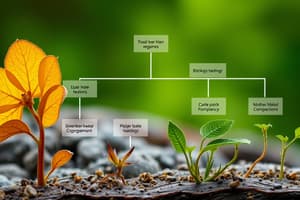Podcast
Questions and Answers
Which of the following are characteristics of living things? (Select all that apply)
Which of the following are characteristics of living things? (Select all that apply)
- Reproduce and grow (correct)
- Take in sunlight only
- Consist of one or more cells (correct)
- Sense and respond to changes in the environment (correct)
All living things can reproduce.
All living things can reproduce.
True (A)
What is the smallest unit of life?
What is the smallest unit of life?
- Cell (correct)
- Molecule
- Atom
- Organ
What is homeostasis?
What is homeostasis?
How do autotrophs obtain energy?
How do autotrophs obtain energy?
Humans share a common ancestor with all other organisms.
Humans share a common ancestor with all other organisms.
Which of the following features is distinctive to humans?
Which of the following features is distinctive to humans?
Living things are composed of ______.
Living things are composed of ______.
What does evolution refer to?
What does evolution refer to?
Flashcards are hidden until you start studying
Study Notes
Learning Objectives
- Understand characteristics that define life and humans.
- Explore the organization and diversity of life.
- Familiarize with the steps involved in the scientific method.
Characteristics of Life
- Living and nonliving entities share the property of being composed of atoms.
- Distinctive features of living organisms include:
- Utilization of energy and matter for sustenance.
- Ability to sense and respond to environmental changes.
- Capacity to grow and reproduce, reliant on DNA.
- Composition of one or more cells, emphasizing cell theory.
- Maintenance of homeostasis for internal balance.
- Evolutionary capability leading to adaptation and change over time.
Energy and Nutrient Requirements
- Autotrophs (plants, bacteria, some protists) obtain energy from sunlight and raw materials like carbon dioxide and water, conducting photosynthesis.
- Heterotrophs (animals, fungi) derive energy by consuming other organisms, ultimately tracing back to solar energy.
Sensory Response
- Living organisms respond to stimuli:
- Humans retract from heat.
- Plants orient growth towards light.
- Bacteria navigate away from harmful substances.
Growth and Reproduction
- DNA, the distinctive genetic material, enables organisms to reproduce and pass on genetic information.
Cellular Composition
- A cell is recognized as the fundamental unit of life; all living things contain at least one cell.
- Cell theory encompasses the idea that all cells arise from pre-existing cells.
- Organisms can be unicellular (e.g., amoebas) or multicellular (e.g., rabbits).
Homeostasis
- Homeostasis refers to the regulation of an organism's internal environment within a specific range essential for survival.
- Example: Human body temperature regulation around 37°C, managed through physiological responses like sweating and shivering.
Evolutionary Dynamics
- Evolution signifies the alteration in genetic traits' frequency within a population over time.
- Natural selection favors individuals with advantageous traits, enhancing their survival and reproduction prospects.
Our Place in the Natural World
- Humans are a product of biological evolution, linking them to all organisms.
- Taxonomically, humans are mammals classified within the animal kingdom of the domain Eukarya.
Distinctive Human Features
- Unique traits of humans include advanced dexterity, large brain capacity, complex analytical skills, sophisticated communication capabilities, and social interactions.
Organization of Life
- Life's structure involves multiple levels of organization:
- Starts with atoms and molecules, leading to the formation of cells.
- Cells integrate to form tissues, which compose organs, and finally organize into comprehensive organ systems.
Studying That Suits You
Use AI to generate personalized quizzes and flashcards to suit your learning preferences.




